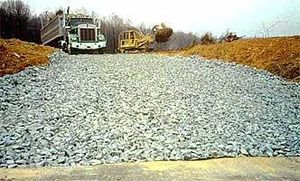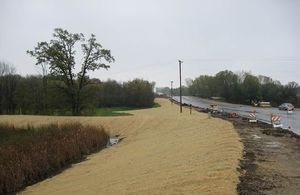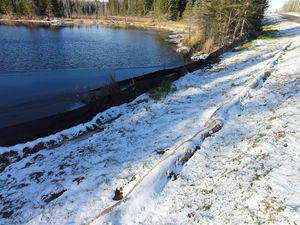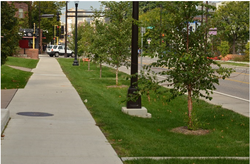
Difference between revisions of "MS4 Staff Site Plan Review Guidance"
m |
|||
| Line 3: | Line 3: | ||
The [[Glossary#M|Municipal Separate Storm Sewer System]] (MS4) [https://stormwater.pca.state.mn.us/index.php?title=MS4_General_Permit permit requires the permittee to conduct site plan reviews]. Permittees must perform and document site plan reviews for construction projects that disturb one acre or more of land. The site plan review ensures active and post-construction requirements of a permittee's regulatory mechanism (e.g. code, ordinance, law) are met. The MS4 Permit requires the regulatory mechanism to be as stringent as the [https://stormwater.pca.state.mn.us/index.php/Construction_stormwater_permit MNR100001/Construction Stormwater Permit]. | The [[Glossary#M|Municipal Separate Storm Sewer System]] (MS4) [https://stormwater.pca.state.mn.us/index.php?title=MS4_General_Permit permit requires the permittee to conduct site plan reviews]. Permittees must perform and document site plan reviews for construction projects that disturb one acre or more of land. The site plan review ensures active and post-construction requirements of a permittee's regulatory mechanism (e.g. code, ordinance, law) are met. The MS4 Permit requires the regulatory mechanism to be as stringent as the [https://stormwater.pca.state.mn.us/index.php/Construction_stormwater_permit MNR100001/Construction Stormwater Permit]. | ||
| − | This permit requirement is somewhat vague and has led to people not realizing that they need to review plans for specific items. The items identified below are the minimum that must be evaluated during a stormwater site plan review under the MS4 and Construction Stormwater Permits. For each site plan review performed, permittees must document the project name, location, total acreage to be disturbed, owner and operator of the proposed construction activity, and any stormwater related comments used to approve or deny the project. If you’d like to conduct a more comprehensive review, please see the MPCA’s [https://www.pca.state.mn.us/sites/default/files/wq-strm2-47.pdf SWPPP Checklist]. During the site plan review, you must verify that site plans include the information listed on this page. | + | This permit requirement is somewhat vague and has led to people not realizing that they need to review plans for specific items. The items identified below are the minimum that must be evaluated during a stormwater site plan review under the MS4 and Construction Stormwater Permits. For each site plan review performed, permittees must document the project name, location, total acreage to be disturbed, owner and operator of the proposed construction activity, and any stormwater related comments used to approve or deny the project. If you’d like to conduct a more comprehensive review, please see the MPCA’s [https://www.pca.state.mn.us/sites/default/files/wq-strm2-47.pdf Stormwater Pollution Protection Plan (SWPPP) Checklist]. During the site plan review, you must verify that site plans include the information listed on this page. |
[[media:SitePlanReviewGuidance.pdf| Here's a PDF version of this page]] | [[media:SitePlanReviewGuidance.pdf| Here's a PDF version of this page]] | ||
Revision as of 16:01, 28 July 2017
The Municipal Separate Storm Sewer System (MS4) permit requires the permittee to conduct site plan reviews. Permittees must perform and document site plan reviews for construction projects that disturb one acre or more of land. The site plan review ensures active and post-construction requirements of a permittee's regulatory mechanism (e.g. code, ordinance, law) are met. The MS4 Permit requires the regulatory mechanism to be as stringent as the MNR100001/Construction Stormwater Permit.
This permit requirement is somewhat vague and has led to people not realizing that they need to review plans for specific items. The items identified below are the minimum that must be evaluated during a stormwater site plan review under the MS4 and Construction Stormwater Permits. For each site plan review performed, permittees must document the project name, location, total acreage to be disturbed, owner and operator of the proposed construction activity, and any stormwater related comments used to approve or deny the project. If you’d like to conduct a more comprehensive review, please see the MPCA’s Stormwater Pollution Protection Plan (SWPPP) Checklist. During the site plan review, you must verify that site plans include the information listed on this page.
Here's a PDF version of this page
(1) BMPs to minimize erosion
(2) BMPs to minimize the discharge of sediment and other pollutants
(3) BMPs for dewatering activities
(4) Site inspections and records of rainfall events
(5) BMP maintenance
(6) Management of solid and hazardous wastes on each project site
(7) Final stabilization upon the completion of construction activity, including the use of perennial vegetative cover on all exposed soils or other equivalent means
(8) Criteria for the use of temporary sediment basins
Contents
- 1 Best Management Practices (BMPs) to minimize erosion
- 2 BMPs to minimize the discharge of sediment and other pollutants
- 3 Site inspections and rainfall records
- 4 BMPs for dewatering activities
- 5 BMP maintenance
- 6 Management of solid and hazardous waste
- 7 Final stabilization when construction is complete
- 8 Use of temporary sediment basins, if applicable
- 9 Post-construction stormwater management
Best Management Practices (BMPs) to minimize erosion
| Stabilization schedule must be no less than: |
|---|
| 14 days for all exposed soils |
| 7 days if a discharge point is within one mile of a special or impaired water |
| 24 hours for areas within 200 ft of a public water during fish spawning times |
| 24 hours for areas of ditches and swales within 200 ft of the property edge or surface water discharge point and 14 days for remainder |
BMPs to minimize erosion are the first line of defense for protecting stormwater from sediment running off your site. Soil without proper erosion control, such as blanket, mulch, or vegetation is prone to erosion. When reviewing site plans, ensure effective erosion control methods are described and located in the appropriate areas.
- Erosion control BMPs
- Schedule and effective methods to immediately stabilize soil
- Energy dissipation at pipe outlets
- 100 foot or more buffer from a special or impaired water
- Schedule to stabilize drainage ditches or swales
- Plan to route water around unstabilized areas
- Plan to discharge water from BMPs to vegetated areas
For more information on site stabilization see this page.
BMPs to minimize the discharge of sediment and other pollutants
Properly installed and maintained sediment control BMPs, such as silt fence or bioroll, prevent sediment from discharging from your site. They allow stormwater to pass through, but filter out sediment. When reviewing site plans, ensure that sediment controls to be used will be effective for the scale of the site.
- Sediment control practices
- Sediment control for temporary soil stockpiles
- Temporary sedimentation basins, if applicable
- 50 foot buffer maintained adjacent to surface waters or redundant sediment controls otherwise
- Plan for using polymers or flocculants if conventional erosion and sediment controls cannot be used:
- Chemicals must be appropriate for the soil type
- Chemicals must be used and dosed correctly
Site inspections and rainfall records
| Insepction schedule must be no less than: |
|---|
| Every 7 days during active construction |
| Within 24 hours after a 0.5 inch rain event |
| If work is suspended due to frozen ground, inspections must begin within 24 hours after runoff occurs or construction starts |
| For parts of the site with permanent cover but work is ongoing elsewhere, inspections can be once per month |
| If the entire site has permanaent cover and there is no active construction, inspections can be once per month for twelve months |
Site inspections must be conducted by a trained person every seven days and within 24 hours of a rainfall event equal to or greater than 1/2 inch. The Construction Stormwater stormwater pollution prevention plan (SWPPP) should document the person responsible for site inspections and any modified inspection frequency.
- Schedule for inspecting and recording inspections
- Documentation of inspections, including:
- date and time of inspection
- inspector name
- inspection findings and corrective actions
- recent rainfall events of 0.5 inches in 24 hours
- observed discharge and discharge points
- proposed amendments to the site plan
Link to a construction stormwater inspection checklist
BMPs for dewatering activities
When done correctly, dewatering activities will only discharge clear water. Therefore, when applicable, SWPPPs should include the following.
- A plan to discharge sediment-laden water to a sedimentation basin
- A plan for dewatering to prevent discharge of sediment laden water, erosion, and downstream impacts
BMP maintenance
| BMP maintenance schedule must be no less than: |
|---|
| End of next business day for nonfunctioning BMPs |
| End of next business day or as soon as conditions allow for nonfunctioning perimeter control |
| 72 hours or as soon as conditions allow for draining sedimentation basins |
| 24 hours for tracked sediment |
| 7 days for removing deltas and sediment from surface water and restabiliztion |
Sediment control devices are only effective if properly maintained. Ensure SWPPPs note the following schedules and procedures.
- Schedule and procedure to repair and replace adjusted and non-functioning BMPs or perimeter control devices when sediment reaches ½ the device height
- Schedule to inspect surface waters and streets
- Schedule and procedure to maintain sediment basins
- Procedure to remove tracked sediment
- Schedule to inspect infiltration areas
For information on specific construction BMPs go to the Inspection and maintenance section for individual Erosion prevention practices or Sediment control practices.
Management of solid and hazardous waste
| Washout operations specifications: |
|---|
| Washout wastes must not contact the ground |
| Washout operations must not result in runoff |
Properly storing, handling, and disposing of chemicals and building materials protects stormwater. SWPPPs must include methods to prevent chemicals from coming in contact with stormwater.
- Cover on building products, pesticides, herbicides, insecticides, fertilizers, chemicals, and landscape materials
- Plan for properly storing and disposing of waste
- Securing portable toilets
- Process for containing washout wastes
- Defined limited area for vehicle washing, fueling, and maintenance and a plan to contain washing runoff
- Prohibition of engine degreasing onsite
For more information link here.
Final stabilization when construction is complete
Final stabilization will provide long-term protection from sediment loss. SWPPPs must provide a final stabilzation plan.
- Process for stabilizing soils with 70 percent perennial cover and ditches with permanent cover
- Process for cleaning sediment basins and conveyance systems of accumulated sediment
- Removal of temporary erosion and sediment control BMPs
- For residential construction: plan to complete temporary erosion protection and downgradient perimeter control before the property is sold
- For construction on agricultural land: the land must be returned to its preconstruction use
For information on final stabilization and site closure, see the construction specifications for individual BMPs.
Use of temporary sediment basins, if applicable
| Temporary sediment basin live storage: |
|---|
| If the live storage volume is calculated, it must accommodate a 2-year, 24 hour flood event, but cannot be less than 1,800 cubic ft |
| If live storage is not calculated, then the basin must accommodate 3,600 cubic ft of live storage |
Sediment basins are used for to capture stormwater runoff from the site and allow sediment to settle prior to discharge. If the site is using a temporary sediment basin, the SWPPP must describe the following.
- Use of temporary sediment basin if 10 or more acres of disturbed soil drain to one place, or 5 acres if the discharge point is within one mile of a special or impaired water
- Documented live storage volume from each acre drained
- Design that:
- prevents short-circuiting and floating debris discharge
- allows for complete basin drawdown
- has a stabilized emergency overflow
- withdraws water from the surface
- includes energy dissipation for the basin outlet
- is outside of surface waters
- avoids draining to wetlands
- is operational before construction starts
Post-construction stormwater management
| Infiltration prohibitions and limitations: |
|---|
| Infiltration is prohibited where: industrial facilities cannot infiltrate under an NPDES Industrial Stormwater permit, vehicle fueling/maintenance occurs, there is less than 3 ft between the infiltration device and bedrock/seasonably saturated soils, and high levels of contaminants will be mobilized |
| Infiltration is limited within: clay soils, 1,000 ft upgradient or 100 ft downgradient of active karsts, a Drinking Water Supply Management Area, or areas with infiltration rates of >8.3 inches/hour |
Permanent stormwater management systems, like infiltration basins, vegetated filter strips, stormwater ponds, must be designed, constructed, and maintained correctly in order to function properly. SWPPPs must describe these systems and design them to meet the following permit requirements.
- Preference for Green Infrastructure techniques
- No net increase (new development) or net decrease (redevelopment) in
- stormwater discharge volume,
- total suspended solids, and
- total phosphorus.
- Provide the reason infiltration is not allowed, if applicable, and describe the alternative treatment system. See the section on infiltration constraints here.



